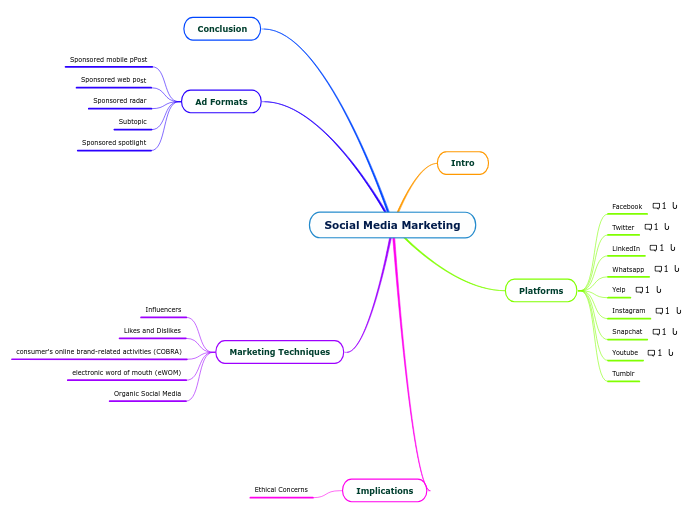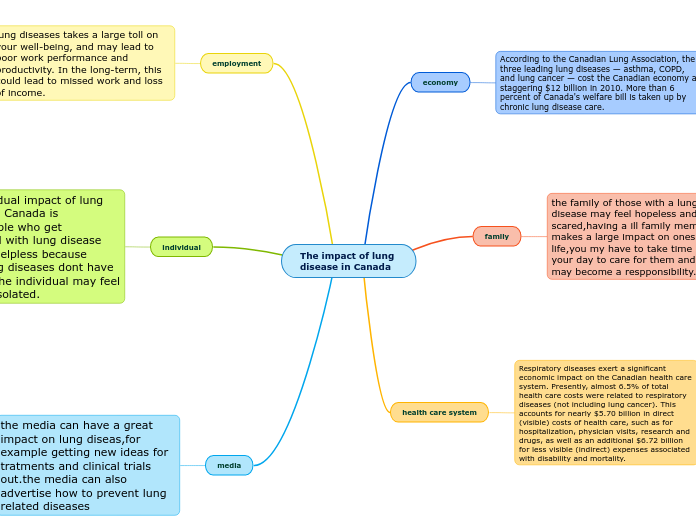Social Media Marketing
Implications
Ethical Concerns
Marketing Techniques
Organic Social Media
electronic word of mouth (eWOM)
consumer's online brand-related activities (COBRA)
Likes and Dislikes
Influencers
Ad Formats
Sponsored spotlight
Subtopic
Sponsored radar
Sponsored web post
Sponsored mobile pPost
Conclusion
Platforms
Tumblr
Youtube
YouTube is another popular avenue; advertisements are done in a way to suit the target audience. The type of language used in the commercials and the ideas used to promote the product reflect the audience's style and taste. Also, the ads on this platform are usually in sync with the content of the video requested, this is another advantage YouTube brings for advertisers. Certain ads are presented with certain videos since the content is relevant. Promotional opportunities such as sponsoring a video is also possible on YouTube, "for example, a user who searches for a YouTube video on dog training may be presented with a sponsored video from a dog toy company in results along with other videos."[62] YouTube also enable publishers to earn money through its YouTube Partner Program. Companies can pay YouTube for a special "channel" which promotes the companies products or services.
Snapchat
Snapchat is a popular messaging and picture exchanging application that was created in 2011 by three students at Stanford University named Evan Spiegel, Bobby Murphy, and Reggie Brown. The application was first developed to allow users to message back and forth and to also send photographs that are only available from 1–10 seconds until they are no longer available. The app was an instant hit with social media members and today there are up to 158 million people using snapchat every single day.[61] It is also estimated that Snapchat users are opening the application approximately 18 times per day, which means users are on the app for about 25–30 minutes per day.[61]
Instagram
In May 2014, Instagram had over 200 million users. The user engagement rate of Instagram was 15 times higher than of Facebook and 25 times higher than that of Twitter.[51] According to Scott Galloway, the founder of L2 and a professor of marketing at New York University's Stern School of Business, latest studies estimate that 93% of prestige brands have an active presence on Instagram and include it in their marketing mix.[52] When it comes to brands and businesses, Instagram's goal is to help companies to reach their respective audiences through captivating imagery in a rich, visual environment.[53] Moreover, Instagram provides a platform where user and company can communicate publicly and directly, making itself an ideal platform for companies to connect with their current and potential customers.[54]
Many brands are now heavily using this mobile app to boost their marketing strategy. Instagram can be used to gain the necessary momentum needed to capture the attention of the market segment that has an interest in the product offering or services.[55] As Instagram is supported by Apple and android system, it can be easily accessed by smartphone users. Moreover, it can be accessed by the Internet as well. Thus, the marketers see it as a potential platform to expand their brands exposure to the public, especially the younger target group. On top of this, marketers do not only use social media for traditional Internet advertising, but they also encourage users to create attention for a certain brand. This generally creates an opportunity for greater brand exposure.[56] Furthermore, marketers are also using the platform to drive social shopping and inspire people to collect and share pictures of their favorite products. Many big names have already jumped on board: Starbucks, MTV, Nike, Marc Jacobs, and Red Bull are a few examples of multinationals that adopted the mobile photo app early. Fashion blogger Danielle Bernstein, who goes by @weworewhat on Instagram, collaborated with Harper's Bazaar to do a piece on how brands are using Instagram to market their products, and how bloggers make money from it. Bernstein, who currently has one and a half million followers on Instagram, and whose "outfit of the day" photos on Snapchat get tens of thousands of screenshots, explained that for a lot of her sponsored posts, she must feature the brand in a certain number of posts, and often cannot wear a competitor's product in the same picture. According to Harper's Bazaar, industry estimates say that brands are spending more than $1 billion per year on consumer-generated advertising.[57] Founder of Instagram Kevin Systrom even went to Paris Fashion week, going to couture shows and meeting with designers to learn more about how style bloggers, editors, and designers are currently dominating much of the content on his application.[58]
Instagram has proven itself a powerful platform for marketers to reach their customers and prospects through sharing pictures and brief messages. According to a study by Simply Measured, 71% of the world's largest brands are now using Instagram as a marketing channel.[59] For companies, Instagram can be used as a tool to connect and communicate with current and potential customers. The company can present a more personal picture of their brand, and by doing so the company conveys a better and true picture of itself. The idea of Instagram pictures lies on on-the-go, a sense that the event is happening right now, and that adds another layer to the personal and accurate picture of the company. In fact, Thomas Rankin, co-founder and CEO of the program Dash Hudson, stated that when he approves a blogger's Instagram post before it is posted on the behalf of a brand his company represents, his only negative feedback is if it looks too posed. "It's not an editorial photo," he explained, "We're not trying to be a magazine. We're trying to create a moment."[58] Another option Instagram provides the opportunity for companies to reflect a true picture of the brand from the perspective of the customers, for instance, using the user-generated contents thought the hashtags encouragement.[60] Other than the filters and hashtags functions, the Instagram's 15-second videos and the recently added ability to send private messages between users have opened new opportunities for brands to connect with customers in a new extent, further promoting effective marketing on Instagram.
Yelp
Yelp consists of a comprehensive online index of business profiles. Businesses are searchable by location, similar to Yellow Pages. The website is operational in seven different countries, including the United States and Canada. Business account holders are allowed to create, share, and edit business profiles. They may post information such as the business location, contact information, pictures, and service information. The website further allows individuals to write, post reviews about businesses, and rate them on a five-point scale. Messaging and talk features are further made available for general members of the website, serving to guide thoughts and opinions.[50]
Whatsapp
WhatsApp was founded by Jan Koum and Brian Acton. Joining Facebook in 2014, WhatsApp continues to operate as a separate app with a laser focus on building a messaging service that works fast and reliably anywhere in the world. Started as an alternative to SMS, Whatsapp now supports sending and receiving a variety of media including text, photos, videos, documents, and location, as well as voice calls. WhatsApp messages and calls are secured with end-to-end encryption, meaning that no third party including WhatsApp can read or listen to them. WhatsApp has a customer base of 1 billion people in over 180 countries.[47][48] It is used to send personalised promotional messages to individual customers. It has plenty of advantages over SMS that includes ability to track how Message Broadcast Performs using blue tick option in Whatsapp. It allows sending messages to Do Not Disturb (DND) customers. WhatsApp is also used to send a series of bulk messages to their targeted customers using broadcast option. Companies started using this to a large extent because it is a cost-effective promotional option and quick to spread a message. As of 2019, WhatsApp still not allow businesses to place ads in their app.[49]
LinkedIn
LinkedIn, a professional business-related networking site, allows companies to create professional profiles for themselves as well as their business to network and meet others.[42] Through the use of widgets, members can promote their various social networking activities, such as Twitter stream or blog entries of their product pages, onto their LinkedIn profile page.[43] LinkedIn provides its members the opportunity to generate sales leads and business partners.[44] Members can use "Company Pages" similar to Facebook pages to create an area that will allow business owners to promote their products or services and be able to interact with their customers.[45] Due to spread of spam mail sent to job seeker, leading companies prefer to use LinkedIn for employee's recruitment instead of using a different job portal. Additionally, companies have voiced a preference for the amount of information that can be gleaned from a LinkedIn profile, versus a limited email.[46]
Twitter
Twitter allows companies to promote their products in short messages known as tweets limited to 140 characters which appear on followers' Home timelines.[34] Tweets can contain text, Hashtag, photo, video, Animated GIF, Emoji, or links to the product's website and other social media profiles, etc.[35] Twitter is also used by companies to provide customer service.[36] Some companies make support available 24/7 and answer promptly, thus improving brand loyalty and appreciation.
Facebook
Facebook pages are far more detailed than Twitter accounts. They allow a product to provide videos, photos, longer descriptions, and testimonials where followers can comment on the product pages for others to see. Facebook can link back to the product's Twitter page, as well as send out event reminders. As of May 2015, 93% of businesses marketers use Facebook to promote their brand.[37] A study from 2011 attributed 84% of "engagement" or clicks and likes that link back to Facebook advertising.[38] By 2014, Facebook had restricted the content published from business and brand pages. Adjustments in Facebook algorithms have reduced the audience for non-paying business pages (that have at least 500,000 "Likes") from 16% in 2012 down to 2% in February 2014.[39][40][41]
Intro









